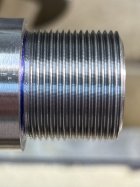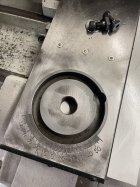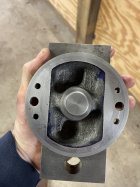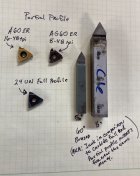Install the app
How to install the app on iOS
Follow along with the video below to see how to install our site as a web app on your home screen.
Note: This feature may not be available in some browsers.
You are using an out of date browser. It may not display this or other websites correctly.
You should upgrade or use an alternative browser.
You should upgrade or use an alternative browser.
Threading Question
- Thread starter Henryrifle
- Start date
@Randfal: Thank you for this post--it's a good one. To date, I have not been using the tailstock to support the tenon area but will try that next. I have been using the compound and figured out the screwy degree marking quickly--it only took TWO barrels with strange looking threads to get that right! Yeah, I am a fast learnerHank,
I miss read you first post. Sorry for high jacking you thread with a long tooling blog since you're already using lay down tooling. Tooling isn't your issue. If your part is supported both sides of the headstock and working close to your spider chuck, that shouldn't be a problem either. I'm assuming you are using the compound to adjust the depth of cut? If not, and you are only using the cross-slide, I would quit doing that and try make the transition to using the compound. And if you are using the compound, I would bump the compound feed angle down(On your particular lathe. If following Old US "How to Run a Lathe" guidelines, they tell you 29.5degs. That won't work on your Grizzly and often overlooked. The degree wheel is positioned differently on asian machines. We use 29degrees on our old Monarchs at work.) to 57-58degs and give it a try. Sometimes it helps to keep the right side of your insert dragging a little to help stabilize it. My Grizzlies sweet spot is 58degs. It won't make a difference to the thread profile in the end.
Thank you for these thoughts and your tooling thoughts...
Hank
Dusty Stevens
Shiner
Big chamferOP, you can always try a bit of chamfer at the lead in of your thread, that was recommended to me and it really seemed to help, don’t know why.
Maybe easing in on cut reduced harmonics?
I like to go with a 45° chamfer of at least the depth of the thread plus 50%. 45° ensures a clean entry to the 30° tool angle.

Yes!Big chamfer
I should have been more specific!
You two nailed it, it’s really helpful!
I also go 45 degrees and at least a few thou past minor diameter
Dusty Stevens
Shiner
I think that anvil screw is pretty important.Got my shim. Stupid question, is the side screw needed, I don't have it. Or is it OK as insert screw goes through both?
View attachment 1433140
Randfal
Silver $$ Contributor
That’s an full thread profile insert for 18 tpi Unifided National” threads. Meant for 18tpi threads and great for gunsmithing; if you’re cutting 18tpi threads common on some actions/tenons. For example: You’d want a 20 UN for Savage and 16UN for Remingtons etc. The A60 insert pictured is a great choice for a person wanting just one or two inserts to start with since it covers most threads. Some still hang on to ground and brazed carbide tooling but face it; they’re junk in comparison to the affordable inserts out there. If you start threading with them and chip a tip…arrrghhh! With an insert, loosen screw, rotate insert and go back to work. No argument is going to win over that. If you haven’t chipped a tip; you haven’t been trying hard enough or haven’t been machining long enough. It will happen sooner or later. And never in the first couple passes. It’ll be down at full depth of cut when the load is greater and you’ve crept up on a final past. Lol.This is the setup I am using:
View attachment 1432981
View attachment 1432982
View attachment 1432983
I believe this is a Carmex 16 ER 18 UN BXC -- Aaron, do you mean BXC or is there an BCX? I don't see that.
Is this the wrong lay-down threader for gunsmithing in stainless steel? I want to say, that I don't believe this is causing a problem, but as several people have asked me to chamber barrels for them, I'd like to produce threads that not only work but look good/great too.
Thank you,
Hank
Attachments
Just a little update. I tried a few of the suggestions in this thread:

Thanks for looking,
Hank
- Cut a more aggressive bevel at the start of the tenon
- I used the live center to add additional support while threading
- I tightened the gibs on both the compound and cross slide
- Thread faster than 70 RPM
- Stop using the compound and only use the cross slide
- Use a treading tool other than the lay-down carbide full profile insert I am currently using
- Try other lubricants

Thanks for looking,
Hank
B Nettesheim
Gold $$ Contributor
It looks like you have a rigidity problem to me, my acer was giving me similar problems which I never experienced until this lathe, the problem with these small “gunsmith lathes” is they lack mass, with that being said any little slop in all parts from the saddle upward will be multiplied by the time you get the tool to the part when they lack mass.
This acer lathe was designed poorly in my opinion because the hole for nuts that hold the compound to the crosslide was drilled from the top not the bottom, and the hole was exactly where you would lock the compound at 30 degrees. The only way to get around this was to drill 4 new holes through the compound and use 4 nuts. I also lapped the 2 parts and it solved chatter problems.

This acer lathe was designed poorly in my opinion because the hole for nuts that hold the compound to the crosslide was drilled from the top not the bottom, and the hole was exactly where you would lock the compound at 30 degrees. The only way to get around this was to drill 4 new holes through the compound and use 4 nuts. I also lapped the 2 parts and it solved chatter problems.


DaveTooley
Gold $$ Contributor
Just an observation from looking at your pic. On your last pass turning the tenon plunge in far enough to get rid of the fillet in the corner. Either that or chamfer the ID of the recoil lug.Just a little update. I tried a few of the suggestions in this thread:
There are some easy changes to try next time:
- Cut a more aggressive bevel at the start of the tenon
- I used the live center to add additional support while threading
- I tightened the gibs on both the compound and cross slide
Results are unchanged from last time. That said the threads work as expected but look amateurish.
- Thread faster than 70 RPM
- Stop using the compound and only use the cross slide
- Use a treading tool other than the lay-down carbide full profile insert I am currently using
- Try other lubricants
View attachment 1448620
Thanks for looking,
Hank
In addition to what others have said, I'd like to point out a few things. First, you mentioned a more aggressive bevel. I assume you mean the chamfer on the tenon before starting the thread. It's hard to see from the angle of the photo, but it looks like you're doing a 30° chamfer which is problematic since it is the same as the angle that the thread insert starts to cut. Better to make it a 45° .Just a little update. I tried a few of the suggestions in this thread:
There are some easy changes to try next time:
- Cut a more aggressive bevel at the start of the tenon
- I used the live center to add additional support while threading
- I tightened the gibs on both the compound and cross slide
Results are unchanged from last time. That said the threads work as expected but look amateurish.
- Thread faster than 70 RPM
- Stop using the compound and only use the cross slide
- Use a treading tool other than the lay-down carbide full profile insert I am currently using
- Try other lubricants
View attachment 1448620
Thanks for looking,
Hank
Next, there is an unevenness to the flats (or complete lack of flats in some cases) which indicates that something has shifted between cutting the tenon and cutting the threads.
Finally, there is some waviness to the flanks which is probably due to any number of uncontrollable factors like lathe rigidity, bearing harmonics, single-phase, etc.
I concurWhat grade/type of inserts are you using? I talked about the BCX inserts that can run slow but the full profile inserts need a little more speed, or they look exactly like that
I had that exact look till I increased my speed.
Going to give speed a try. Threading at 70 RPM today. Next available seed is 200 RPM, almost 300% faster!!!
Hank
Hank
I thread at 10X+ your speed now.Going to give speed a try. Threading at 70 RPM today. Next available seed is 200 RPM, almost 300% faster!!!
Hank
With any carbide tool I’ve tried speed is your friend.
I struggle with the same issues as you. Upon recommendation I swapped my single phase motor to a 3 phase. That seemed to help out some. When I swapped the motor out I set better belt tension. I believe it was related to belt tension the whole time. I’d almost bet that’s your issue as well. my threading looked just like the pictures you’re posting.
Similar threads
- Replies
- 21
- Views
- 5,198
- Replies
- 43
- Views
- 2,064
- Replies
- 42
- Views
- 1,535
Upgrades & Donations
This Forum's expenses are primarily paid by member contributions. You can upgrade your Forum membership in seconds. Gold and Silver members get unlimited FREE classifieds for one year. Gold members can upload custom avatars.

Click Upgrade Membership Button ABOVE to get Gold or Silver Status.
You can also donate any amount, large or small, with the button below. Include your Forum Name in the PayPal Notes field.
To DONATE by CHECK, or make a recurring donation, CLICK HERE to learn how.

Click Upgrade Membership Button ABOVE to get Gold or Silver Status.
You can also donate any amount, large or small, with the button below. Include your Forum Name in the PayPal Notes field.
To DONATE by CHECK, or make a recurring donation, CLICK HERE to learn how.











